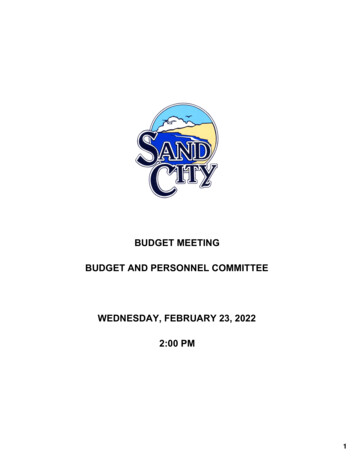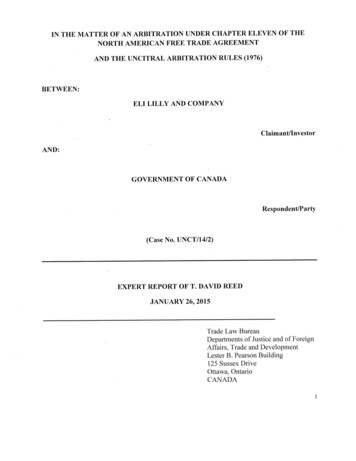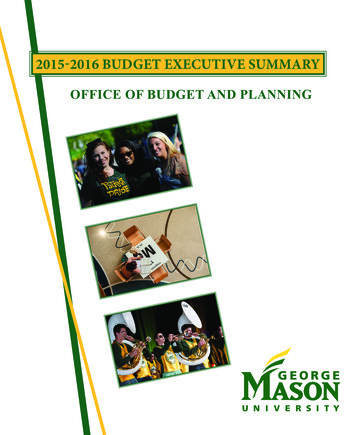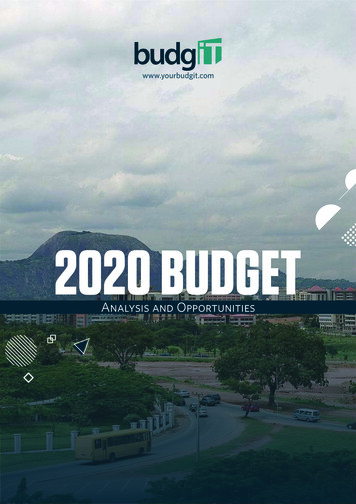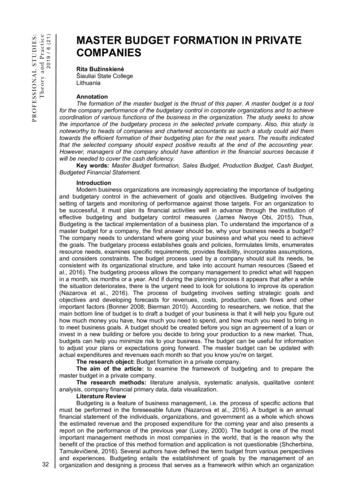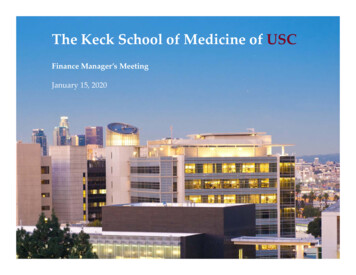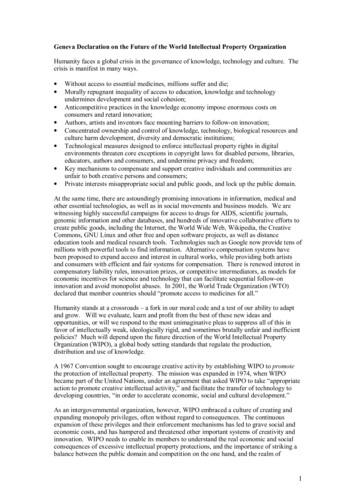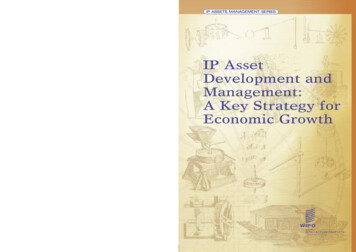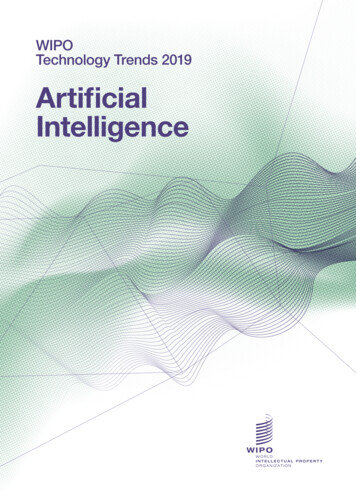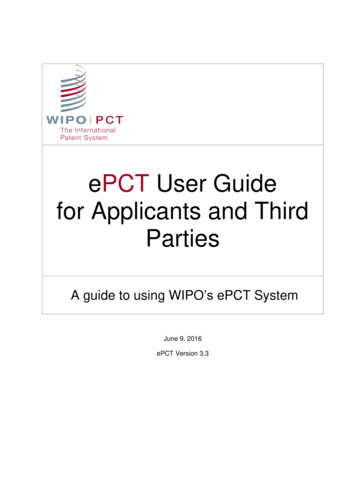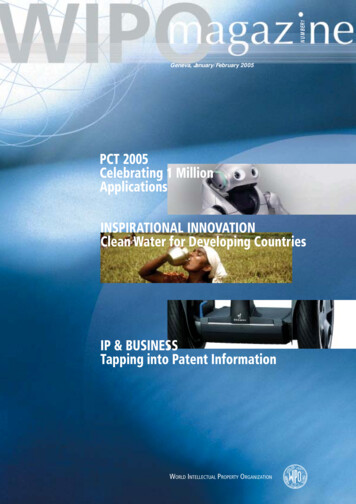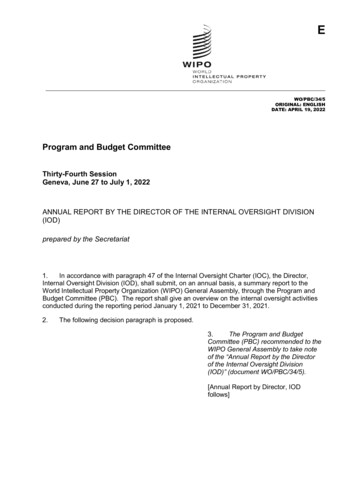
Transcription
EWO/PBC/34/5ORIGINAL: ENGLISHDATE: APRIL 19, 2022Program and Budget CommitteeThirty-Fourth SessionGeneva, June 27 to July 1, 2022ANNUAL REPORT BY THE DIRECTOR OF THE INTERNAL OVERSIGHT DIVISION(IOD)prepared by the SecretariatIn accordance with paragraph 47 of the Internal Oversight Charter (IOC), the Director,Internal Oversight Division (IOD), shall submit, on an annual basis, a summary report to theWorld Intellectual Property Organization (WIPO) General Assembly, through the Program andBudget Committee (PBC). The report shall give an overview on the internal oversight activitiesconducted during the reporting period January 1, 2021 to December 31, 2021.The following decision paragraph is proposed.The Program and BudgetCommittee (PBC) recommended to theWIPO General Assembly to take noteof the “Annual Report by the Directorof the Internal Oversight Division(IOD)” (document WO/PBC/34/5).[Annual Report by Director, IODfollows]
ANNUAL REPORT BY THE DIRECTOR OF THE INTERNAL OVERSIGHT DIVISIONJanuary 1, 2021 to December 31, 2021TABLE OF CONTENTSProgram and Budget Committee . 2LIST OF ACRONYMS . 2BACKGROUND. 3SOME HIGHLIGHTS OF THE PERIOD . 3PLANNING PRINCIPLES . 4PROFESSIONAL STANDARDS . 4GENDER MAINSTREAMING . 4KEY FINDINGS AND HIGH PRIORITY OVERSIGHT RECOMMENDATIONS . 5REPORTED ENGAGEMENTS IN 2021 . 5ENGAGEMENTS STARTED END 2021. 12INVESTIGATIVE ACTIVITIES . 14INSTANCES WHERE INFORMATION OR ASSISTANCE WAS REFUSED . 17STATUS OF IMPLEMENTATION OF OVERSIGHT RECOMMENDATIONS . 17CONSULTATIVE AND ADVISORY OVERSIGHT WORK . 19COOPERATION WITH EXTERNAL OVERSIGHT BODIES . 20OTHER OVERSIGHT WORK . 20IOD QUALITY ASSURANCE AND IMPROVEMENT PROGRAM . 21OVERSIGHT RESOURCES . 22ANNEX–List of IOD reports
WO/PBC/34/5page 2LIST OF ACRONYMSAIMSAdministrative Integrated Management SystemBIBehavioral InsightsCDIPCommittee on Development and Intellectual PropertyCOVID-19Coronavirus diseaseDACDivision for Arab CountriesERMEnterprise Risk ManagementHRMDHuman Resources Management DepartmentIAOCIndependent Advisory Oversight CommitteeIOCInternal Oversight CharterIODInternal Oversight DivisionIPIntellectual PropertyITInformation TechnologyMIRManagement Implication ReportMTSPMedium Term Strategic PlanNIPSNational Intellectual Property StrategyOIOffice InstructionPBCProgram and Budget CommitteePDPerformance DataQAIPQuality Assurance and Improvement ProgramSMARTSpecific, Measurable, Achievable, Relevant, Time-boundTATechnical AssistanceUNUnited NationsUNEGUnited Nations Evaluation GroupWIPOWorld Intellectual Property OrganizationWPRWIPO Performance Report
WO/PBC/34/5page 3BACKGROUND1.The purpose of the World Intellectual Property Organization’s (WIPO) Internal OversightDivision (IOD) is to provide independent and effective internal oversight for WIPO, in line withthe provisions of the Internal Oversight Charter (IOC).2.The IOC requires 1 the Director, IOD, to submit, on an annual basis, a summary report tothe WIPO General Assembly, through the Program and Budget Committee (PBC). The AnnualReport shall give an overview of the internal oversight activities conducted during the reportingperiod, including the scope and objectives of such activities, the schedule of work undertakenand progress on the implementation of internal oversight recommendations.3.In accordance with the IOC, a draft version of the Annual Report has been provided to theDirector General and the Independent Advisory Oversight Committee (IAOC) for theircomments, which have been taken into account in finalizing the report.SOME HIGHLIGHTS OF THE PERIOD4.The year 2021 inherited the risks and uncertainties caused by the Coronavirus disease(COVID-19) Pandemic that had significantly affected 2020. As such, WIPO continued to takeexceptional measures to safeguard lives and minimize the impact of the Pandemic on our work.IOD would like to thank all WIPO colleagues and external service providers who were involvedin ensuring our safety, and supporting our remote work. Let us hope and look forward to animproved 2022.5.IOD notes that 2021 marked the review and adjustment of the results-based managementframework for the coming years, and the elaboration of a new strategic vision. A new MediumTerm Strategic Plan (MTSP) for 2022-2026 was issued, introducing a Strategy House with fourpillars and a foundation. To support this initiative, IOD has also established a Strategy for 2022and 2023, aligned with the MTSP, and will implement a number of strategic initiatives to supportthe Organization in achieving its strategic focus.6.IOD continues to support WIPO in strengthening controls, accountability, transparencyand learning, by introducing innovative and fit-for-purpose tools and practices that will helpmove WIPO towards the highest standards in risk management and program delivery amongothers.7.IOD continues to engage in cross-sectional engagements involving auditors together withinvestigation and/or evaluation professionals. These engagements aim at providing a morecomplete and in-depth review of WIPO Programs. The Review of Crisis Management duringthe Pandemic is one such engagement that required the collaboration of all three functions ofIOD.8.IOD has expanded its services to include advisory and consulting 2 services. An exampleof these services includes providing advice on the process and quality assurance on the inputfor a technical tool on benchmarking and self-evaluation of National Intellectual PropertyStrategies (NIPS).9.IOD has completed a project to support data analytics and continuous auditing, which willenhance the assurance work of the Division. This is a first step to support IOD in establishingRefer to IOC paragraphs 47 and 48.The term Advisory is used when IOD supports the client by providing advice and making comments, but does nottake the lead in managing the activity or producing a formal deliverable.The term Consultancy is used when IOD takes the lead in providing a service whose nature and scope have beenagreed with the client, and provides a formal deliverable in that regard.12
WO/PBC/34/5page 4the right conditions to enable an overall opinion on the WIPO Statement on Internal Controlby 2025.10. Finally, IOD has completed the migration to a new audit and recommendationmanagement system, with up-to-date technology and new features to support effectiveness andefficiency of oversight engagements and management of recommendations.PLANNING PRINCIPLES11. In developing its Oversight Work Plan, IOD considered a number of factors including riskratings, relevance, country impact, oversight cycle, and feedback received from WIPOManagement, Member States, and available resources. Prior to its finalization, the draftOversight Work Plan was also submitted to the IAOC for its review and advice pursuant toparagraph 28(a) of the IOC 3.12. In order to provide effective oversight coverage with the efficient use of limited resources,while avoiding potential overlaps, IOD also considered the work done by the External Auditorand other oversight bodies such as the Joint Inspection Unit and evaluations commissioned bythe Committee on Development and Intellectual Property (CDIP).PROFESSIONAL STANDARDS13. IOD undertakes its audit activities pursuant to the mandatory elements of the InternationalProfessional Practices Framework promulgated by the Institute of Internal Auditors, including itsInternational Standards for the Professional Practice of Internal Auditing, Core Principles for theProfessional Practice of Internal Auditing, Definition of Internal Auditing, and Code of Ethics.14. Similarly, IOD’s investigative work is conducted in line with the Uniform Principles andGuidelines for Investigations endorsed by the Conference of International Investigators.15. For evaluation activities, IOD follows the International Standards in Evaluation Practice asset out by the United Nations Evaluation Group (UNEG).GENDER MAINSTREAMING16. In the context of the UN System-Wide Action Plan Performance Report 4 and with respectto gender equality and mainstreaming in IOD’s work, the current conditions and actions can bereported:(a) IOD consults the Gender and Diversity Specialist during the annual planning andrisk assessment;(b) IOD has included a standing work step on gender mainstreaming issues in its workprogram for applicable oversight engagements. In 2021, some elements of gender wereincluded in the report of the Review of Crisis Management during the Pandemic;(c) The Evaluation Section applies, where applicable, the UNEG Guidance onIntegrating Human Rights and Gender Equality in Evaluations during all phases of theevaluation;Paragraph 28 of the IOC establishes the duties and modalities of work, which includes a requirement that “prior tofinalizing the internal oversight plan, the Director, IOD, shall submit the draft plan to the IAOC for its review andadvice.”4 Since 2021 the United Nations agreed on the landmark UN System-wide Action Plan on Gender Equality and theEmpowerment of Women, or UN-SWAP, to implement the gender equality policy of its highest executive body, theUN Chief Executives Board, chaired by the Secretary-General. Spearheaded by UN Women, the UN-SWAP for thefirst time assigns common performance standards for the gender-related work of all UN entities, ensuring greatercoherence and accountability.3
WO/PBC/34/5page 5(d) A gender focal point has been designated to liaise with the WIPO Gender andDiversity Specialist; and(e) IOD follows up on the implementation of the recommendations issued for the auditand evaluation of the WIPO Policy on Gender Equality.KEY FINDINGS AND HIGH PRIORITY OVERSIGHT RECOMMENDATIONS17. This section contains information on key findings and recommendations, addressing highpriority risks included in internal oversight reports: Audits, Evaluations and ManagementImplication Reports (MIRs) issued during the reporting period.18. The key findings and recommendations are related to the following reports issued duringthe reporting period 5:(a)Audit and Integrity Review of Absence Management;(b)Audit of Cybersecurity Management at WIPO;(c)Review of WIPO Crisis Management during the Pandemic;(d)Review of Performance Management and Staff Development at WIPO;(e)Evaluation of the Regional Division for Arab Countries;(f)Evaluation of WIPO Match;(g)Evaluation of the Use and Impact of IOD Evaluation Section Recommendations;(h) Advisory Engagement on National Intellectual Property (IP) StrategySelf-Evaluations;(i)MIR on Personal data and privacy issues concerning WIPO e-mails to externalusers; and(j)MIR on Information contained in the PATENTSCOPE website.19. IOD has continued its dialogue with Management to regularly review and update thestatus of the implementation of open recommendations. All recommendations are addressedby Management through an action plan with suggested activities, responsible staff, and adeadline for implementation. Oversight recommendations are managed in the TeamMate 6system, which is accessible by IOD and WIPO Management.REPORTED ENGAGEMENTS IN 2021AUDIT AND INTEGRITY REVIEW OF ABSENCE MANAGEMENT20. IOD noted a number of positive developments in the management and administration ofstaff absences including:(a) The training of staff members to access the Administrative Integrated ManagementSystem (AIMS) Human Resources (HR) remotely;The list of reports features in the Annex.TeamMate TM is a specialized software for audit management, which covers, among others, the audit universe andrisk assessments, engagement planning, electronic working papers, and recommendations management.56
WO/PBC/34/5page 6(b) The introduction of a Payroll validation tool to automate the reconciliation of staffentitlements and salary deductions for sick leave; and(c) The implementation of guidelines on Return to Work following Long-term SickLeave.21. These developments helped in enhancing the efficiency and effectiveness of managingvarious absences particularly sick leave (certified and uncertified), special leave, and annualleave.22. Opportunities exist to enhance the management of various absences in the Organization.For example, the Human Resources Management Department (HRMD), in collaboration withrelevant internal stakeholders, should assess the relevant Office Instruction (OI) on sick leave,and the current workflows and practices for managing certified sick leave, with a view toidentifying and making necessary changes to ensure alignment. More specifically, HRMDshould strengthen the internal controls over medical appointments by randomly selecting staffmembers and verifying that their appointment(s) complies with the requirements of the relevantOI.23. The management of sick leave can be further enhanced by developing a data migrationplan in order to have a more comprehensive, reliable and accurate determination of theprogress made in migrating sick leave data in EarthMed. Further, establishing a mechanismthat facilitates comprehensive reporting on the cost of sick leave, which includes both qualitativeand quantitative cost elements combined with targeted information sessions and proactiveinformation sharing between HRMD (including the Medical Unit) and relevant ProgramManagers and supervisors (subject to medical confidentiality), would help improvecommunication and informed operational decisions (e.g. back filling).24. In addition, the Organization would benefit from customizing EarthMed to capture relevantand granular medical data that can be analyzed to identify useful trends and statistics, performroot cause analysis, and generate tailored reports. Other improvements would includecompleting the development of an interface between AIMS HR and EarthMed (subject tomedical confidentiality) that would enhance the efficiency and effectiveness of managing staffabsences.25. Finally, adding a checkbox in the AIMS HR absence request form for leave forfamily-related emergencies, to serve as a declaration of honor, would reinforce accountability,compliance and consistency with the requirements set out in the relevant OI.AUDIT OF CYBERSECURITY MANAGEMENT AT WIPO26. The Review found that overall, WIPO has established a mature cybersecuritymanagement program, commensurate with WIPO’s risk appetite statement and globally alignedwith best practices implemented by organizations and private sector firms with similarinformation security objectives, including a fit-for-purpose Governance Framework and SecurityArchitecture. The budget of the Security and Information Assurance Division was found to bealigned with the information security objectives.27. The cybersecurity posture was found to be overall effective. Some non-widespread,non-critical vulnerabilities were identified and are being addressed.28. IOD made recommendations to further reinforce the cybersecurity posture of theOrganization, by, among others, aligning the Information and Communication TechnologyStrategy and Information Security Strategy, increasing incident drills and cyber war games,enhancing the Configuration Management Database for inventorying critical assets, andcontinuing to engage with third party service providers to ensure that they take measures toreinforce their respective cybersecurity postures.
WO/PBC/34/5page 7REVIEW OF WIPO CRISIS MANAGEMENT DURING THE PANDEMIC29. COVID-19, which was declared a Pandemic by the World Health Organization onMarch 11, 2020, posed a significant threat to people, businesses and organizations around theglobe. Given the possibility of similar crises occurring in the future, and the extent and durationof the associated operational disruptions, it is essential that WIPO’s response be effective andsustainable to ensure that it continues to deliver on its strategic focus.30. The review found that WIPO has established a well-functioning Governance Structure forcrisis management. The responsible teams covered operational, tactical and strategicdecision-making and were well integrated in the day-to-day activities of the Organization.Furthermore, IOD found that the existing policies and procedures were adequate in managingthe crisis, and management made necessary updates and changes as required. TheOrganization successfully applied the WIPO Organizational Resilience Framework by deployingWIPO Crisis Management Plans and taking other relevant actions. The Organization executedits crisis management policies and procedures and adjusted its systems of Risk Managementand Internal Controls to the conditions of the Pandemic. Going forward, WIPO needs to identifyBusiness Continuity Focal Points at the sector levels, to further enhance the operationalizationof the Organizational Resilience Framework.31. IOD supplemented its substantive work with three surveys, aimed at WIPO staff,supervisors and Member States, to capture valuable insights on, and perception of, theOrganization’s management of the crisis, and related lessons learned. The survey resultshighlighted Flexibility and Work-life Balance as a predominant theme from WIPO staff members,while a majority of supervisors mentioned that the crisis helped re-think the operationalprocesses and make them more efficient, economic and effective without compromising thequality of outputs. Comments from participating Member States focused on the importance ofvirtual meetings (hybrid meetings, webinars, online training, among other things), and the needto continue with these formats where feasible as they have proven to be one of the valuablechanges resulting from the Pandemic. The Organization can make further enhancements byassessing external stakeholders’ needs in the area of additional communication andcollaboration platforms.32. IOD identified lessons learned and made recommendations in the areas of crisisgovernance and communication, human resource management, execution of, and compliancewith, relevant policies and procedures, and internal controls that would help further refine crisismanagement processes, and benefit the Organizational Resilience Framework.REVIEW OF PERFORMANCE MANAGEMENT AND STAFF DEVELOPMENT AT WIPO33. The review found that the current performance management process at WIPO is based ontraditional Performance Management principles. Furthermore, the current model hashighlighted key issues such as:(a)Lack of trust in the performance process;(b)Absence of a continuous feedback culture and fear of having difficult conversations;(c) Heavy burden to manage administrative workload for managers, as the system iscomplex and not user-friendly;(d)Perception of a “tick-box” exercise with little added value to people;(e) From an organizational standpoint, while the Performance Management and StaffDevelopment System is effective in ensuring alignment in task-related objectives, it is notyet functioning as an integrated tool that encourages development and the growth mindsetnecessary for WIPO’s strategic ambitions; and
WO/PBC/34/5page 8(f)Lack of mobility means that certain staff may be “stuck” in a position where theycannot flourish.34. Further, managers need to enhance their performance management skills, in particularwhen dealing with underperformance. They tend to show reluctance in tacklingunderperformance, which could result in inflated ratings to avoid, among others, theadministrative burden linked with addressing underperformance.35. Finally, the level of maturity of WIPO’s current performance management was assessedagainst seven pillars (purpose, culture, people, process, Information Technology (IT) system,reward and recognition, and career development). Most pillars were found to be at the initialdevelopment stage, indicating that more needed to be done to develop a mature performancemanagement culture in order to, among others, effectively achieve the strategic goals of theOrganization.36. Going forward, both managers and employees have expressed the need for changeincluding:(a) More objectivity, recognition and development, supported by a more user-centricand simple process;(b) Additional support from the Organization to efficiently address challenges in tacklingunderperformance; and(c) The need for a deep cultural evolution of mindsets and behaviors aroundperformance.37. Furthermore, to address key challenges in performance management, the Organizationwould need to, among others:(a)Strategically shift towards more customer-centricity;(b)Drive towards a “growth mindset”, fueled by a culture of performance and feedback;(c) Be more agile and innovative, which is presently hindered by a lack of flexibility inthe current Performance Management process; and(d) Put measures in place to upskill management and address the current resistance tomove away from traditional professional behaviors.38. Finally, it would be crucial to establish a new simplified and flexible performancemanagement model, adapted to WIPO’s environment, supported by clear communication andfeedback mechanisms. Middle management will be a key enabler to bring the new model totheir teams and apply these precepts to day-to-day work.EVALUATION OF THE REGIONAL DIVISION FOR ARAB COUNTRIES (DAC)39. The DAC is part of the Regional and National Development Sector at WIPO. The DAC’smain mandate is to coordinate WIPO's development-oriented, demand-driven technicalassistance (TA) in collaboration with all relevant WIPO's business units, while accounting for thedistinctiveness and priorities of the Member States, the specificities of the region, and gendermainstreaming. In addition, the DAC is responsible for providing TA to the 22 Arab countries toenable them to modernize their registration operations and better use IP assets to reap thebenefits from the IP system.40. The purpose of this evaluation was formative, oriented to learning and programimprovement.
WO/PBC/34/5page 941.The major findings of the report are the following:(a) The Division’s support to the Member States in the Arab region was relevant to thenational priorities and was aligned with country needs;(b) Provided TA consisted mostly of ad-hoc activities identified according to the MemberStates’ priorities with limited integration of the strategic vision of the planned outcomes ineach country. Some stakeholders highlighted that the selection criteria set up for TAactivities by the DAC were not clear;(c) The majority of stakeholders consider the Division as their main reference for anyIP-related issues. However, the Division tends to generally focus on the diplomaticaspects of its functions rather than project management and technical side;(d) The evaluation findings noted that the Division relies on self-reporting indicators andsome of them do not have a sufficiently clear methodology for data collection andanalysis;(e) The evaluation highlighted some areas that require more attention from the Divisionand its internal collaborators such as the monitoring and evaluation putting higheremphasis on measuring delivered activities over the results; and(f)The Division’s efforts to contribute to the impact and sustainability of its activitieshas been observed only in some of the Arab countries. Such efforts have not culminatedinto widespread endorsement of national strategies and changes in policy. The Divisionhas yet to develop a medium to long-term, results-based, country-specific plan/roadmapwith the national IP counterparts and a broad use of partnerships to facilitate suchchange.42. Based on the findings and conclusions of the evaluation, the major recommendations ofthe Report include:(a) Developing a joint DAC-Country specific outcome-driven medium to longer-termprogram/plan (3-5 year plan) that ensures the coherence of interventions, while remainingflexible to emerging needs;(b) Revisiting the Division’s Performance Framework in order to identify means ofmeasurement, and to ensure alignment and avoid inconsistencies among them;(c) Strengthening partnerships with national and regional counterparts and theirrespective Permanent Missions by increasing visibility and developing medium tolonger-term program/plans of action; and(d) Fostering close cooperation with other international organizations (United NationsConference on Trade and Development, World Trade Organization and others) to poolresources, maximize the impact and ensure sustainability in (i) formulating and rolling outNIPS; (ii) influencing Innovation Strategies; and (iii) providing complementary support toaddress emerging regional needs.EVALUATION OF WIPO MATCH43. "WIPO Match” is a global stakeholder community that aims at harnessing the industry andprivate sector's power to promote economic, social, and cultural development in developingcountries, least developed countries, as well as countries in transition. It does this by helping IPTA seekers to find relevant providers for projects and local engagements.
WO/PBC/34/5page 1044. The purpose of this evaluation was formative, focused on finding learning opportunitiesand program improvement.45.The major findings of the report are the following:(a) WIPO Match was developed in response to a request from the CDIP and aligned torecommendation 9 of the Development Agenda;(b) WIPO Match’s value proposition has evolved over time and it includes an amalgamof services and proposals that the project is not always in a position to realistically deliverto all platform members. Currently, services and feedback from the program do not reachall seekers, thereby limiting the potential for widespread progress of the project;(c) Nevertheless, there are significant efficiency challenges related to the context inwhich WIPO Match operates, which need to be addressed by the Organization;(d) Interviewed stakeholders believed that there is room for improvement in theoperations of WIPO match;(e) Since its inception in ten years until 2019, WIPO match could only catalyze sixdeals;(f)The evaluation also found that the criteria used to become a member of the platformis not clear enough to realize its full potential; and(g) The WIPO Match web platform technology is outdated, and it does not comply withtoday's platform standards. The existing web platform limits the project team's efficiency,as several tasks need to be done manually.46. Based on the findings of the evaluation, the major recommendations of the report includethat:(a) Senior Management jointly with the Project Manager should strengthen governanceby establishing a governance structure for decision making and formalizing reportingmechanisms on interim results, challenges and lessons learned;(b) The Project Manager, with the leadership of Senior Management and in consultationwith relevant stakeholders, should develop a strategy for the effective and efficientmanagement and sustainability of WIPO Match; and(c) Senior Management, jointly with the Project Manager and in collaboration withHRMD, should revise the job descriptions of all WIPO Match staff members to reflectactual duties and responsibilities. Moreover, they should provide adequate resources torealize the vision articulated in the strategy document. An upgrading of the database toensure that it is fit for purpose might also be required.EVALUATION OF THE USE AND IMPACT OF IOD EVALUATION SECTIONRECOMMENDATIONS47. To support WIPO in maximizing the impact of its services, the IOD Evaluation Sectiondeveloped an evaluation approach using the latest research methods in behavioral science.48. Behavioral Insights (BI) are lessons derived from the behavioral and social sciences,including decision making, psychology, cognitive science, neuroscience, organizational andgroup behavior. Public bodies around the world are increasingly using BI to design andimplement better public policies based on evidence of the actual behavior and biases of citizensand businesses.
WO/PBC/34/5page 1149. BI help understand how context and other influences can impact decision-making andinform the actual behavior of people and organizations. The BI approach focuses onunderstanding what drives the decisions and behaviors of citizens, rather than relying on anassumption of how they should act. By doing so, it helps ensure that policies reflect actualneeds and behaviors for greater impact and effectiveness.50. A BI experts’ team conducted a behavioral analysis of the evaluation process, defined asthe distance between the expected behavior that stakeholders should exhibit and the realbehavior that ultimately occurs.51. The goal of this document was to recognize, identify and address human bias whenengaging in evaluation by using the knowledge produced by BI and “nudges” to increase theusefulness and impact of evaluations.52. The practical use of this hand
entitlements and salary deductions for sick leave; and (c) The implementation of guidelines on Return to Work following Long-term Sic k Leave. 21. These developments helped in enhancing the efficiency and effectiveness of managing various absences particularly sick leave (certified and uncertified), special leave, and annual leave. 22.
